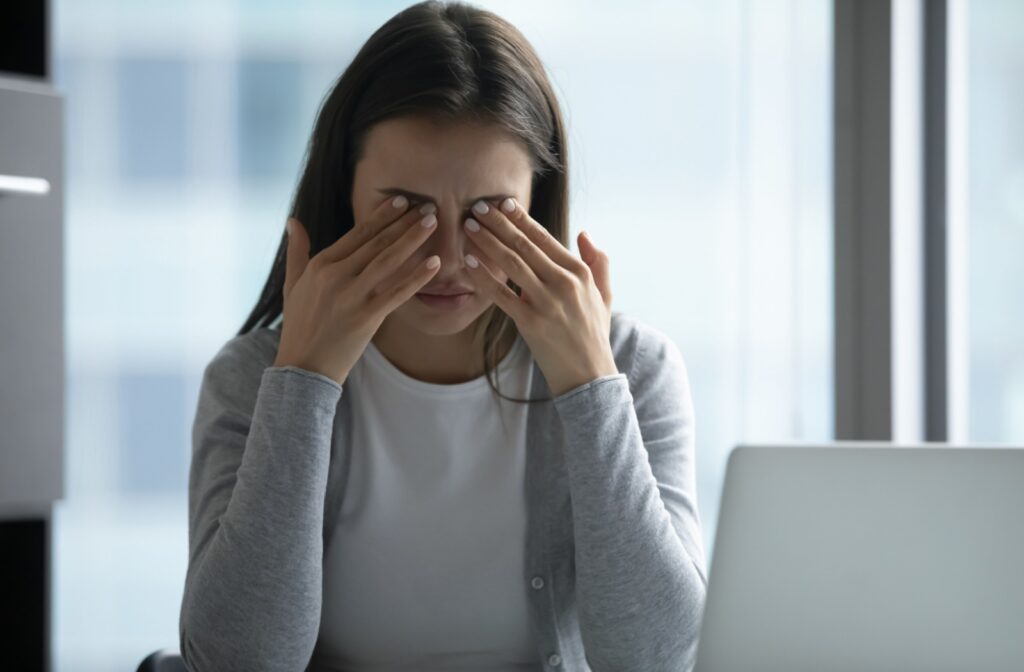For millions of people worldwide, dry eye is more than just uncomfortable; it can be a daily struggle affecting every part of their lives.
Recognizable by the stinging and burning sensations, dry eye is an extremely common eye condition that can be difficult to treat without your optometrist’s help. But if you leave it untreated, can dry eyes lead to blindness?
When you deal with chronic dry eye, your eyes are left unprotected for long periods of time. They can’t flush away dirt, debris, or other contaminants. This increases the overall risk of infections, abrasions, and other damage to the eye, which can sometimes lead to blindness.
This is why dry eye treatment should be prioritized; it can help preserve your vision.
What Is Dry Eye?
Dry eye is exactly how it sounds—it’s a condition that causes your eyes to feel dried out. This is caused by an imbalance with your tear film.
When healthy, your tear film helps to protect the eye. It lets light pass through unobstructed while flushing away bacteria, debris, and irritants that could damage the eye. This tear film requires a careful balance of liquids to properly do its job, but this balance can sometimes be thrown off.
If your tear film isn’t properly functioning, the tears can’t do their job. They may evaporate too quickly, or there might simply be too few tears produced. This condition, called dry eye, leaves the eye exposed and easily inflamed and leads to symptoms like:
- Redness in the eyes
- A stinging or burning sensation
- Watery eyes, which is the body’s response to the irritation of dry eyes
- A gritty feeling, as if something is in the eye
- Blurred vision, especially after long periods of focus
- Sensitivity to light
- Fatigue in the eyes
- Difficulty wearing contact lenses
So what causes dry eye?
What Causes Dry Eye?
The cause of dry eye can vary as much as the symptoms; it can develop due to many different contributing factors.
Inside your eyelids, you have tiny little glands called the meibomian glands. They produce a layer of oils for your tear film that prevents your tears from evaporating too quickly. These glands can become plugged or obstructed, so your tear film no longer has enough of these protective oils. The tears can evaporate too quickly and leave the eye exposed.
However, this isn’t the only cause of dry eye. It can also be caused by:
- Age-related changes in the body.
- Environmental factors like dry air, wind, or smoke.
- Certain medications, including antihistamines and blood pressure drugs, which can reduce tear production.
- Autoimmune diseases, such as Sjögren’s syndrome, that affect moisture-producing glands throughout the body.
- Increased screen time causing us to blink less often (most of the time without even realizing it!)
This is why a proper assessment with an eye care professional is so essential. Your optometrist can examine your eyes to determine the cause of your discomfort; then, they can recommend appropriate treatment.
Can Dry Eyes Make You Go Blind?
With dry eyes, treatment is essential. But it’s about more than just finding temporary relief from the inflammation and irritation.
When your tears aren’t properly protecting your eye, the surface of the eye itself is exposed. Debris, dust, contaminants, bacteria—the odds of these causing damage can increase significantly. When your tear film is working properly, it flushes away potential hazards when you blink. But when it’s compromised, the eye has to work harder to remove damaging particles.
This increases the risk of scratching or damaging your eye. Abrasions, infections, and other problems are all more likely to develop. This can lead to scarring on the cornea, which can lead to long-term vision problems. While this is rare, it’s still a possibility, meaning long term dry eye should definitely be treated.

How to Treat Dry Eyes
Dry eye treatment isn’t just about relief. It’s about preventing vision loss, preserving your eye health, and addressing the underlying cause of your dry eyes.
Treating dry eye is our specialty, we offer a range of effective treatments and can help determine which is appropriate for your specific case. Some possibilities include:
Eye Nutrition & Lifestyle Changes
Your eyes are extremely complex and require certain vitamins, minerals, and nutrients to properly function. Your tear film is no exception—certain nutrients like Omega-3 fatty acids contribute to healthy tear production.
Our team can assess your eyes to determine how certain lifestyle adjustments, such as blinking exercises, and food choices and supplements can help promote healthy tear production in your eyes.
At-Home Treatments
At West Valley Dry Eye, we offer a variety of at-home treatments to help manage your dry eye symptoms. These dry eye products include:
- Artificial tears
- Ointments
- Eyelid cleaners
- Eye masks and compresses
- Supplements (Omega-3)
- Oculaire skin care
Our eye doctors are happy to recommend the right products for your dry eye symptoms.
TearCare
TearCare is a technology-focused approach to treating dry eyes where a pair of flexible devices are applied to the eyelid. These apply gentle amounts of heat to the area, stimulating the meibomian glands to break up blockages and improve the flow of natural oils.
Intense Pulsed Light (IPL) Therapy
Intense pulsed light, or IPL, is a promising approach to treating the imbalance in your tear film. Gentle amounts of light are precisely applied to the eyelids, liquefying any blockages near the meibomian glands. This helps the oils flow freely to the tear film, which can reduce long-term symptoms of dry eye.
iLux MGD Treatment
iLux treatment involves a small handheld device. It gently warms the eyelids, heating the meibomian glands and removing any hardened oils. Meanwhile, it gently compresses the eyelid, removing any liquefied debris from the area.
Low-Level Light Therapy (LLLT)
Low-level light therapy, or LLLT, involves the application of light to the area encircling your eyes, encompassing both the eyelids and eyebrows. This gentle process provides warmth to the region, aiding in the unclogging of the meibomian glands by melting away any trapped oil or debris.
Many patients find this treatment to be relaxing and stress-free. All you need to do is recline in a chair while we dedicate approximately 15 minutes to help alleviate your dry eye symptoms.
Radiofrequency (RF)
Radiofrequency, or RF, treatment is an effective intervention for addressing dry eyes. This innovative approach utilizes controlled heat energy to target and liquefy obstructive oils within the meibomian glands. By facilitating the breakdown of these oils, your tears regain their natural balance, and those pesky blockages are cleared. It’s like a spa day for your eyes!
Try Dry Eye Therapy with Our Team
Dry eye can be an uncomfortable experience, but you don’t have to needlessly suffer the symptoms. Instead, reach out to our team. At West Valley Dry Eye, our focus isn’t just on bringing you temporary relief—we believe in treating you as a whole to help you have long-lasting eye health.
Book an appointment with our team today to take the first step toward trying dry eye therapy!


